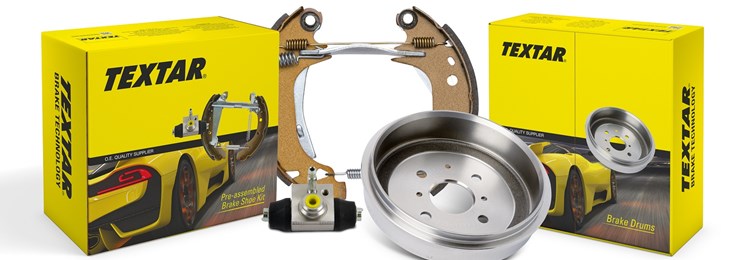
Interview with: Michael Dunkel, Director Global Category & Product Management at TMD Friction about current trends, changes and challenges on the subject of commercial vehicles
Date: Thursday 05 May 2022
Requirements for brakes for light commercial vehicles, such as the 3.5-tonne commercial vehicles, which are often used in parcel services: How do the materials differ from those in normal cars? Hydraulic braking systems are generally used for these brakes.
The use of light commercial vehicles continues to rise, with 2021 seeing around 8 per cent more vehicles registered in the EU, despite problems with the supply of microchips. Due to the intensive application and the use of hydraulic car braking systems, these light vans also represent an excellent opportunity for automotive workshops to increase their revenue.
Textar also covers the entire market for brake pads, brake discs and our other product groups in this vehicle segment. Since safety is a major issue in this segment, workshops should be able to rely on high-quality parts with know-how about the original equipment. The market demands longer pad durability, both for cost reasons and to ensure that brake repair is not needed in the interim between service intervals. Therefore, we use more wear-resistant friction material mixes.
As a development partner for OEMs, brake and axle manufacturers, we are able to rely upon a large number of materials that we have developed in-house, so we have at our disposal material mixtures that have significantly improved service lives, without compromising on safety or noise generation. The pedal feel, another important safety factor, also remains constant.
With increasing electrification in the commercial vehicle sector (especially in distribution traffic), there will certainly also be effects on the brake system. Will the drum brake be making a comeback, like with the electric car (VW ID3/4)?
Most electric commercial vehicles, whether they use hydraulic or air brakes, have so far used the same brakes as cars that run on internal combustion engines. Most likely, this will only change with the next generation of vehicles, probably in the direction of weight reduction.
The drum brake is still used in commercial vehicles today, for example when used for construction site transport. Whether the future will once more bring an increased use of drum brakes in this application remains to be seen.
There is also a marked trend among amongst vehicle manufacturers to, for cost reasons, bring cheaper secondary brands onto the market. As an OE/Tier 1 supplier, how do you handle this?
Of course, we have to come to grips with this market trend, which is why, in addition to our premium brand Textar, in the commercial vehicle sector we also offer our Don brand. Here, too, the approach is to offer broad market coverage for various brake, axle and vehicle manufacturers, coupled with an attractive price/performance ratio. The quality of this brand is recognised in the markets, and ultimately we draw on our many years of know-how to enable safe braking with standardised friction materials.
Ultimately, as a friction specialist, we want to meet the requirements of the various market segments as well as those of our customers. We can let the market decide: OE quality with the TEXTAR brand or premium aftermarket quality with the DON brand.
The use of two-piece brake discs have been on the rise in the passenger car sector for years. Will we soon see them in heavy commercial vehicles as well?
Two-piece brake discs are not new to the commercial vehicle sector and have already been in use by some manufacturers for several years. Certainly, the biggest challenge for brake discs in the commercial vehicle sector is to dissipate the resulting heat and to dissipate it effectively.
There are various designs for two-part brake discs that optimise the thermal insulation between the wheel hub and the brake disc and thus reduce heat transfer. This results in more uniform temperature distribution, thus preventing excessive distortion of the brake disc. This helps avoid so-called hotspots, which in turn lead to differing levels of tension in the brake disc and thus to cracks. The aim is to avoid cracks, and especially cracks running all the way through!
They offer various carrier plates which have a lower weight. Is it worthwhile to retrofit such braking technology?
Together with our partners from the brake, axle and vehicle industries, we have decisively advanced the readiness of the cast carrier plate for production. In addition, we have combined this with various designs that offer an optimal connection to the friction material, i.e., a secure connection is ensured even in the face of high thermal loads and aggressive external influences.
Not only that, but we were also able to optimise the weight of the conventional steel carrier. Thanks to the optimal shape of the pad carrier, the same component strength can be achieved as with conventional lining support, while simultaneously reducing the weight.
The different types of brake callipers or brake systems do enable a complete changeover or standardisation of the pad carriers. There is a clear quality advantage to using TEXTAR-brand brake pads developed for specific applications. We do our development and testing in Germany. We have five test benches available there, as well as our own test fleet, and test capacities in England.
The availability of parts plays a major role, especially in commercial vehicles. Are you affected by the current supply chain issues?
We have currently been noticing some more difficult access to the raw materials, but basically we are very well positioned there and are able to rely on a good network of suppliers. Our commercial vehicles production is 100 per cent "Made in Germany”, and we recently built a new, high-capacity central warehouse in Leverkusen-Hitdorf: these are two very important factors that have ensured good availability for us in the last two years.
About TMD Friction
TMD Friction, a wholly-owned subsidiary of Nisshinbo Holdings Inc., is a leading global manufacturer of brake pads for the automotive and brake industries. In addition to disc brake pads and brake linings for cars and commercial vehicles, the company’s product portfolio includes brake pads for motor racing and friction materials for the industry. TMD Friction supplies the worldwide aftermarket with the Textar, Mintex, Don, Pagid, Cobreq, Nisshinbo and Bendix brands. TMD Friction also develops and produces friction linings for the industry under the Cosid brand name. The TMD Friction Group has four locations in Germany and others in Europe, the USA, Brazil, Mexico, China and Japan, and employs 4,500 people worldwide.
More information is available at http://www.tmdfriction.com.
